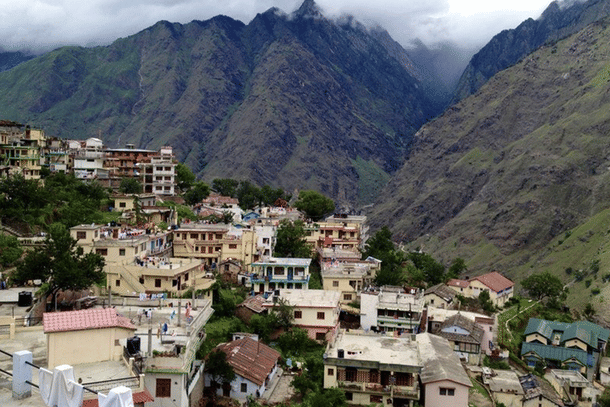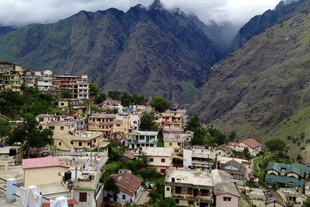Ground Reports
Joshimath Land Crisis: What Does Reading The Geography And Man-Made Growth Tell About The Sinking Town
Ankit Saxena
Jan 12, 2023, 04:57 PM | Updated Jan 13, 2023, 01:49 PM IST
Save & read from anywhere!
Bookmark stories for easy access on any device or the Swarajya app.


The crisis in Joshimath has intensified with cracks emerging in more buildings and in the ground. Taking appropriate charge of the situation, the Uttarakhand and the central governments have come forward with relief and rehabilitation measures.
Orders have been issued to all concerned authorities for preventing further risks. All structures prone to any risks have been vacated, and the evacuated citizens are being rehabilitated to safer grounds.
Considering the severity, the government has suspended all construction activities happening in and around the region. At the same time, a team of experts along with the local authorities are critically engaged in finding out the reasons for these incidents and planning further response to the existing conditions.
The cracks have reportedly developed in as many as 731 buildings till date, which include houses, hotels and other building structures in Joshimath. It has been labelled as the “Sinking Town”, as these cracks are a result of continuous land subsidence, as stated by the District Disaster Management Department.
The authorities and experts suggest that there could be multiple reasons for these events. Extensive construction, to impacts of past disasters faced by the region along with the subsequent changes in the region’s ecology may have triggered such events.
However, many in public are opposing the larger infrastructure development projects ongoing in the Himalayan region. The criticism targets these projects to be solely responsible for the crisis.
Such actions deviate concern from identifying the larger issues and determinants of these challenges. It becomes important to look in depth at all concerning factors.
Reading the geographical and scientific facts along with the growth trajectory of the town, will provide better understanding of the natural character of the region, occurrence of land subsidence, and the appropriate steps to be taken further.
Overview Of The Town
Joshimath is a hilly town in Chamoli District of Uttarakhand, situated at a height of 1,875 m. The town serves as a tourist base that has grown highly over the last two decades.
It lies as a connecting town for tourists visiting many important religious and tourist locations of Uttarakhand. These include Badrinath, Valley of Flowers, Hemkund Sahib and Auli.
The area holds strategic importance for the Indian Armed forces and is base for the Garhwal Scouts.
Looking at the geographical character of Joshimath, the surrounding land is covered with thick layers of overburdened materials. It is formed on the old landslide debris of boulders and weathered rocks, with loose soil character. The land maintains a low soil bearing capacity and falls in the high-risk seismic Zone-V.
Development Concerns At Regional Level
Land subsidence, faced by the town, is defined as the sinking of the ground due to movement of material beneath the ground. This can occur due to reasons of loose soil, removal or seepage of water into the ground. It can stir up due to actions such as soil erosion, earthquakes and disturbances to the land.
Experts have suggested that land subsidence might have occurred due to unplanned construction activities with increasing population and growth of the town.
The debris on which the town rests, is experiencing strain with its weak land slope due to this growth. The region is also a seismic zone, which makes it prone to frequent earthquakes.
According to locals, with increased attraction for tourists, several new hotels, residences and other useful buildings have come up in forms of multi-storey structures, in the last ten years.
The problem of land instability got worse with this increase in construction, that largely remained unplanned and neglected the low bearing capacity, as per a survey report from the Uttarakhand State Disaster Management Authority (USDMA) from September 2022. The published report mainly mentioned the ill-planned construction in the town as an important reason behind land sinking.
Additionally, inadequate drainage systems and lack of waste water disposal might have also contributed to the land subsidence.
Geologist Yaspal Sundriyal from the Srinagar Garhwal-based Hemvati Nandan Bahuguna (HNB) Garhwal University, said that since there is no wastewater management, most houses have soak pits that have pushed down loose material into the ground, resulting in the land sinking.
The extreme actions of nature and weather events have also contributed to this land crisis. Several regions of Uttarakhand have experienced devastating calamities over the years. The USDMA report on Joshimath states that erosion in the area increased after the 2013 and 2021 floods.
The Disaster Mitigation and Management Centre (DMMC) data states that from 2015 to 2021, Uttarakhand witnessed 7,750 instances of cloudbursts and extreme rains which often resulted in floods. The existing drains have also been found to be choked with the silt from the 2013 flooding that occurred in the region.
Actions To Move Forward
While dealing with the current crisis, the primary concern remains the safety of the resident population and preventing loss of life and resources.
Further, with certain issues arising regionally, it calls for attention to local and town level planning and development. The issues also raise concerns on the feasibility of land for expansion and growth of the town.
The growth of such towns requires regulated planning initiatives for further development. Preparing masterplans and construction norms at regional levels, that respect the uniqueness of the land character, are needed. These steps will promote safe construction of residences and building structures for the settlements in risk prone towns like Joshimath.
Drainage planning is another factor that needs to be studied and redeveloped. Many reports mention that the town is suffering from poor drainage and sewer management, as more waste is seeping into the soil, loosening it from within.
The situation at Joshimath brings in various complex reasons that could have led to the current situation, including factors of rapid growth of the town, geographical features and the larger geological experiences of the region.
It is irrelevant to uniquely oppose the infrastructure projects and consider them the sole reason for such crisis.
While the teams of experts are still working to identify the direct factors for these events at Joshimath, this issue of land subsidence also brings to notice many other similarly growing mountain towns, which need to move forward with conscious planning and mindfulness of the ecology of the regions.





